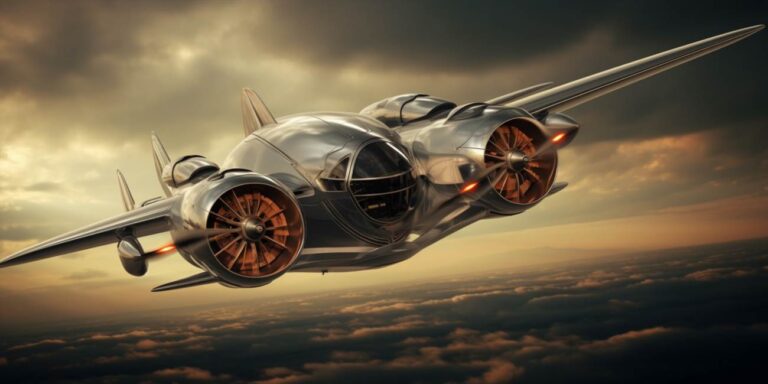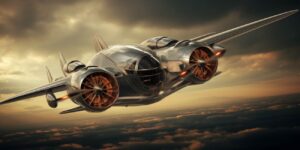Over the decades, experimental aircraft have witnessed remarkable innovations, adapting to emerging technologies and scientific breakthroughs. In the 1940s, after World War II, the era of experimental aviation truly took flight. Engineers and aviators began to experiment with unconventional designs and propulsion systems.
In the 1950s, the era of jet-powered experimental aircraft dawned, introducing a new dimension to aeronautical experimentation. Notable examples include the X-1, which broke the sound barrier, and the X-15, an iconic high-speed research aircraft. These pioneers laid the groundwork for subsequent breakthroughs in high-speed flight.
Advancements continued into the 1960s and 1970s, marked by a focus on supersonic experimental aircraft. The development of the XB-70 Valkyrie, a supersonic strategic bomber, showcased the ambition to explore sustained high-speed flight. This period also saw the emergence of variable-sweep wings, allowing aircraft to optimize performance at different speeds.
The 1980s and 1990s witnessed a surge in stealth technology applied to experimental aircraft. The Lockheed F-117 Nighthawk, with its distinctive angular shape, exemplified a breakthrough in radar-evading design. Concurrently, the quest for fuel efficiency led to the exploration of unmanned experimental aircraft, paving the way for contemporary drone technology.
As we entered the 21st century, the focus shifted towards hypersonic experimental aircraft. The X-43, an unmanned scramjet-powered aircraft, set records for sustained hypersonic flight. These endeavors aimed to unlock new realms of speed and efficiency, challenging the very limits of aerospace engineering.
Today, experimental aircraft encompass a diverse range of projects, including electric propulsion, autonomous flight systems, and reusable spaceplanes. Electric propulsion, driven by environmental concerns, aims to revolutionize air travel with cleaner and more sustainable energy sources.
The introduction of autonomous flight systems heralds a new era in aviation, where machines navigate the skies with unprecedented precision. Meanwhile, the development of reusable spaceplanes reflects the ambition to make space travel more accessible and cost-effective.
Innovative engine designs in experimental aircraft over time
Throughout the evolution of experimental aircraft, innovative engine designs have played a pivotal role in pushing the boundaries of aerospace technology. These daring endeavors have not only defied conventional norms but have also laid the foundation for advancements in aviation. Let’s embark on a journey through time, exploring the revolutionary engine concepts that have propelled experimental aircraft to new heights.
One of the earliest breakthroughs in engine design for experimental aircraft dates back to the mid-20th century. During this period, engineers experimented with jet propulsion, marking a departure from traditional propeller-driven systems. The adoption of jet engines allowed aircraft to achieve unprecedented speeds, paving the way for supersonic flight.
The Cold War era saw intense rivalry between nations, driving a surge in aerospace innovation. Engineers were tasked with developing engines that not only provided speed but also ensured fuel efficiency and reliability. This led to the emergence of turbofan engines, a design that combined the best of jet and propeller technologies, delivering enhanced performance and fuel economy.
As the turn of the century approached, experimental aircraft became testbeds for cutting-edge technologies. The focus shifted towards variable cycle engines, allowing for adaptability in different flight conditions. These engines featured adjustable components, optimizing performance during takeoff, cruise, and combat scenarios.
Advancements in materials science played a crucial role in shaping engine designs. The introduction of composite materials allowed for the development of lightweight yet durable components. This not only improved the power-to-weight ratio of engines but also enhanced overall aircraft performance.
With the dawn of the 21st century, electric propulsion emerged as a disruptive force in experimental aircraft design. Electrically driven engines offered a cleaner and more sustainable alternative to traditional fuel-based systems. These electric propulsion systems opened new possibilities for stealth, reduced environmental impact, and increased mission endurance.
Recent years have witnessed a surge in hypersonic flight research, pushing the limits of engine capabilities. Experimental aircraft are now equipped with scramjet engines, enabling sustained hypersonic speeds. These engines utilize the forward motion of the aircraft to compress incoming air, eliminating the need for traditional intake systems.
Groundbreaking experimental aircraft fuselage and wing designs
The realm of aviation has recently witnessed a revolution in experimental aircraft designs, pushing the boundaries of conventional structures. Engineers and innovators have embarked on a journey exploring the blended wing body, a paradigm-shifting concept that challenges the traditional fuselage and wing configurations.
At the forefront of this aviation renaissance is the forward-swept configuration, an audacious departure from the classic swept-wing design. This innovative approach involves positioning the wings in a forward direction, defying the long-established norm of rearward sweep. The benefits of such a design extend beyond mere aesthetics; it enhances maneuverability and stability, introducing a new dimension to the aircraft’s performance envelope.
Complementing the forward-swept wings is the reverse delta shape, an integral component that amplifies the aircraft’s aerodynamic efficiency. Unlike the conventional delta wing, the reverse delta incorporates a unique trailing-edge sweep, optimizing lift distribution and reducing drag. This design synergy results in improved fuel efficiency and enhanced overall performance, setting a new standard in aviation engineering.
The marriage of blended wing body, forward-swept, and reverse delta culminates in an experimental aircraft that challenges the status quo. The blended wing body not only integrates the wings seamlessly into the fuselage but also maximizes internal volume, offering increased payload capacity and fuel efficiency.
One of the remarkable achievements of this avant-garde design is its impact on aerodynamic drag. The forward-swept wings, coupled with the reverse delta, contribute to a substantial reduction in drag, paving the way for enhanced speed and fuel economy. The inherent stability of the blended wing body configuration further augments the overall flight dynamics, ensuring a harmonious balance between agility and control.
As we delve deeper into the technical aspects, the forward-swept wings mitigate the effects of wingtip vortices, reducing turbulence and enhancing the aircraft’s performance in various flight regimes. This breakthrough in aerodynamics not only improves efficiency but also opens doors to novel possibilities in both military and civilian applications.
Examining the design intricacies reveals the meticulous engineering behind each component. The blended wing body seamlessly integrates the wings into the fuselage, creating a harmonious and efficient structure. The forward-swept wings, marked by their distinctive angle, redefine the principles of lift and agility. Meanwhile, the reverse delta shape optimizes airflow, minimizing drag and maximizing efficiency.
To illustrate the significance of these design elements, let’s consider a comparison table:
| Design Aspect | Conventional Design | Blended Wing Body with Forward-Swept Wings and Reverse Delta |
|---|---|---|
| Aerodynamic Efficiency | Standard | Enhanced |
| Maneuverability | Conventional | Optimized |
| Internal Volume | Limited | Maximized |
This table succinctly encapsulates the transformative impact of the blended wing body forward-swept reverse delta design, heralding a new era in aviation. The integration of these cutting-edge concepts propels aircraft technology into uncharted territories, promising a future where efficiency and performance coalesce in perfect harmony.
Novel experimental aircraft control and stability systems
Novel experimental aircraft control and stability systems have ushered in a new era of aviation, pushing the boundaries of conventional designs. Among these innovations are the remarkable technologies of fly by wire, augmentor wing, and warped wing.
The introduction of fly by wire (FBW) systems has revolutionized the way pilots interact with the aircraft. Unlike traditional mechanical linkages, FBW replaces them with electronic systems, translating pilot inputs into electronic signals. This not only enhances control precision but also enables the implementation of advanced control algorithms. The result is an aircraft that responds more efficiently to pilot commands, increasing both safety and maneuverability.
One of the groundbreaking concepts intertwined with FBW is the augmentor wing. This innovative technology integrates seamlessly with FBW, enhancing the aircraft’s performance by dynamically adjusting wing parameters. The augmentor wing essentially acts as an adaptive extension to the traditional wing structure, optimizing lift and drag in real-time. This dynamic capability significantly improves fuel efficiency and overall aerodynamic efficiency, contributing to a more sustainable and cost-effective aviation ecosystem.
Parallelly, the concept of warped wing further extends the possibilities of aircraft design. Unlike static wings, a warped wing incorporates a flexible structure that allows for shape-shifting during flight. This adaptability enables the aircraft to optimize its wing configuration based on current flight conditions, providing unparalleled versatility. Paired with FBW, the warped wing enhances stability and control, offering a unique combination of agility and efficiency.
Combining fly by wire with augmentor wing and warped wing technologies results in a synergistic effect, pushing the boundaries of what was previously considered possible in aviation. The integration of these systems creates an aircraft that not only adapts to pilot inputs but also dynamically adjusts its aerodynamic profile to achieve optimal performance. The synergy between these technologies opens up new possibilities for future aircraft designs, paving the way for a more efficient, sustainable, and agile aviation industry.






